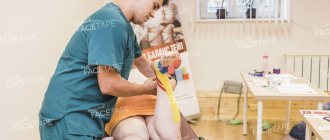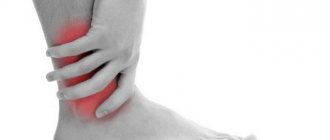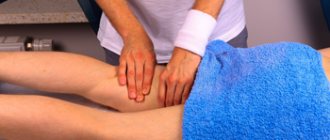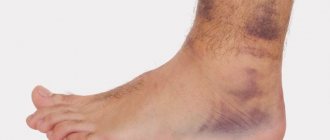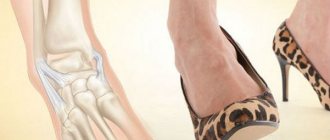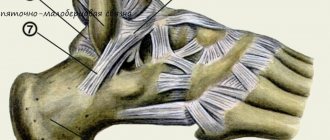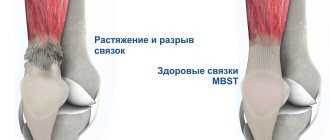Articles Doing a lot of work, walking and physical activity every day leads to tension in all body systems. The ankle joint is no exception, which allows a person to walk confidently and smoothly without losing balance.
The main function of the ankle joint is to constantly monitor the condition and function of the foot during walking. The goal of the ankle is to redistribute the load from the heel to the toe.
The important and daily work of the ankle leads to rapid wear and tear of the joint and the risk of serious leg injury. If unpleasant or painful sensations occur, you should immediately and promptly fix the ankle joint in its natural (correct) position to prevent more serious problems and injuries.
An ankle brace can be effectively used to simply and reliably fix the joint in an anatomically correct position to prevent its further and severe displacement and relieve severe pain.
Wearing time
The general rule is this: wear your ankle as much as your doctor recommends. However, you need to start gradually.
Getting used to your ankle is like getting used to a new pair of shoes. The first four days are especially important. On the first day, wear an ankle brace for one hour and severely limit physical activity. On the second day, wear the ankle for 2 hours, on the third day - for 4 hours, on the fourth - for 6 hours. If you feel like you are forcing the adaptation period, add only 30 minutes each day. At the same time, increase your level of physical activity.
The adjustment period usually lasts from one to six weeks. Orthopedists recommend switching to permanent ankle wear no earlier than two weeks later. Having adapted to the orthosis, you can wear it all day, which will dramatically increase the effectiveness of its effect on the joint and ligaments.
What is an ankle orthosis and why is it needed?
An ankle orthosis, or a bandage as it is also called, is a special orthopedic device that is made of durable textile materials. A very important feature of this material is its elasticity.
In appearance, the orthosis resembles an ordinary sock. In order to provide a more secure fit to the foot, plastic inserts or metal components can be additionally inserted between the fabric.
Ankle orthoses provide the necessary orthopedic regime and the correct position of the damaged joint, reduce the level of stress and pain, provide a warming effect and micro-massage to improve blood circulation. Also, wearing orthoses helps correct deformities of the musculoskeletal system.
The orthosis not only allows you to support the foot in the correct and comfortable position, but also does not restrict movement, provides the leg with the opportunity to move correctly when walking, facilitates the recovery process after injury, and protects the joint from additional loads and negative effects on it.
Ankle orthoses as a therapeutic or prophylactic agent are prescribed by doctors or rehabilitation specialists for the following purposes:
- fixation and protection of the ankle joint, as one of the constituent elements of complex treatment of various disorders of the human musculoskeletal system;
- for preventive purposes for people who engage in a lot of physical activity - athletes, tourists, lovers of active recreation and frequent walking;
- for people who are overweight, the bandage helps reduce stress on the joints;
- supporting the foot in a normal state in the presence of a tendency to deformation and pathological processes;
- prevention and prevention of injuries or inflammation of the foot joints for people who, due to their professional activities, expose their limbs to daily, prolonged and severe stress;
- to reduce or relieve foot pain;
- to reduce the time required for full recovery from injuries, increase the level of regeneration and speed up the recovery of patients.
Pain syndrome
If you experience severe pain while wearing your ankle boot, remove it and carefully examine your leg for irritation. Minor discomfort and the appearance of pinkish spots at the points of maximum correction (pressure) are considered normal. This stain should disappear within 20 minutes after you remove the orthosis. Gently massage your foot and put the ankle back on after one to two hours.
If the redness does not go away within 20 minutes and you experience severe pain or unbearable pressure in the area of the bony prominences when you reapply the orthosis, remove the orthosis and consult a podiatrist as soon as possible. Your ankle needs more precise adjustment.
Ankle brace for ruptured and sprained ligaments
The ankle is a trochlear joint. This means that it is designed for movements in one plane: that is, for flexion and extension of the foot. Thus, any, even the slightest deviation from the axis of the joint leads to sprain or rupture of the ligaments . The stronger the deviation, the more significant the injury: from a slight subluxation to a fracture.
An ankle bandage is used to prevent injuries, sprains, ligament ruptures, as well as to quickly restore movement in the ankle joint after a sprain and after a ligament rupture.
An ankle compression bandage is a product made of elastic knitted fabric, which is used as a foot brace and as a shin brace for children and adults. The ankle brace has compression properties that restore blood supply and quickly reduce swelling in the ankle area.
The prophylactic bandage , or ankle support "Intex", exerts pressure on the leg within 15-18 mmHg. Soft fixation of the ankle without restricting movement in the joint reduces the likelihood of dislocation and reduces the risk of sprain and rupture of ligaments during sports.
An ankle brace of compression class 1 (18-22 mm Hg) is used for the first and second degree of sprain: pain, slight or moderate swelling and discomfort when walking, as well as for a speedy recovery after removing the plaster for an uncomplicated ankle fracture (without displacement).
An elastic ankle brace, which has a compression class of 1, has a micro-massage effect on the leg, stimulating blood flow and lymph outflow in the lower leg area. This improves nutrition of damaged ligaments and also accelerates the reduction of swelling.
In the third degree of sprain and rupture of the ligaments, which is characterized by sharp pain, instability in the joint and the inability to lean on the leg when walking, rigid fixation of the ankle using an orthosis or plaster is often required. An ankle bandage of compression class 2 (23-32 mmHg) is used after removing the fixator to stabilize the joint.
Since ligament rupture is often accompanied by damage to the blood and lymphatic vessels, severe swelling occurs in the ankle area. The external pressure exerted on the leg by a compression class 2 bandage improves blood supply to the injured area. This promotes the rapid restoration of the essence of blood and lymphatic vessels, which quickly reduce post-traumatic swelling.
Skin care
During the period of using the ankle, be especially careful about your foot hygiene. Wash your feet every day with mild soap, taking care of your heels and between your toes.
Cotton socks, knee socks or stockings will help avoid friction and keep your skin dry. The main condition is that the sock must be at least 5 cm above the ankle. Be sure to change your socks every day, and if possible, a couple of times a day.
Check your skin every night for redness, irritation, and chafing. If you have diabetes, check your feet and legs frequently and remember to use appropriate foot creams.
What should insoles be like?
Anatomically shaped insoles relieve tension from the muscles, minimize compression when walking, so the likelihood of displacement, dislocations and twisting is reduced. The leg is fixed in the correct position, the load is distributed harmoniously, and the ligamentous-muscular system is unloaded.
Ideally, for those who have already experienced treatment for osteoarthritis, it is advisable to select custom-made insoles. Spring-type insoles should be made of non-rough, breathable fabric according to your personal measurements, taking into account foot defects. Only in this case will they soften the shock load when walking.
A heel higher than 5 cm is a huge danger to the joints
So, the best option for arthrosis would be sports shoes with thin (2-3 cm) flexible elastic soles, made of soft materials, with a minimum of hard parts. Ideally, it should be more than just comfortable: provide arch support and shock absorption. How to determine this? It’s very simple: just try on the pair you like and take a dozen steps in it.
The choice of shoes is important at any stage, be it minor stiffness in the joints in the morning with arthrosis of the first degree or an already developed disease. If you are undergoing treatment, for example, a course of intra-articular injections of Noltrex for gonarthrosis or coxarthrosis, pay close attention to the selection of boots or sneakers. The right shoes are especially important during the rehabilitation period so that the pain goes away for a really long time!
How to put on an ankle
If there are no special instructions from the orthopedist, the ankle section is put on in a sitting position. To begin, put on a long sock or stocking. Make sure the sock is pulled on neatly, without folds or gathers. Then put the ankle on your leg and secure it with the existing straps and fasteners according to the design features. Make sure that the heel is in place in the orthosis. Only then put on your shoes using a shoehorn. Never go outside in light or semi-rigid ankles without shoes. Unless otherwise directed by your doctor, remove the ankle at night.
How to wear a wrist brace
The wrist brace is as easy to put on as a sports wristband. And the degree of fixation can be easily adjusted with a Velcro fastener.
Such an orthosis can be of two types:
- is worn only on the wrist area of the hand;
- is worn on the wrist and thumb for secure fixation.
Most often, a wrist orthosis is worn before playing sports or physical activity. It is worn when there is a load on the wrist joint to prevent injury.
If the orthosis is used for injuries or in the post-traumatic period, it must be worn all day. It is advisable to remove it at night to prevent muscle atrophy.
Contraindications
It is prohibited to use a wrist joint orthosis if:
- high level of destruction (destruction) of the joint;
- skin diseases and inflammations in the area of application of the product;
- allergies to the material from which the orthosis is made;
- malignant skin tumors at the site where the orthosis is worn.
Shoes
If you are going to wear an ankle brace with shoes, choose shoes that properly support your foot. If you buy new shoes, try them on with your ankle on your foot to choose the most comfortable model.
Shoes should have a closed toe and closed heel, preferably with a removable insole, low heels (no higher than 1.5 cm) and slightly wider than your normal size. If the heel is too high, you will feel pain in your knee or back. It is important that the heels on all pairs of shoes used are the same height.
When wearing ankle boots, you should give preference to shoes with Velcro fasteners or lace-ups in order to have more opportunities to adjust the circumference of the foot. The longer the lacing, the better.
"Minimalist Shoes"
There are also such developments on the market - very thin sneakers with a very flexible sole. Moving in them imitates walking barefoot: the design lacks support for the subtalar joint and ankle. Today, according to progressive orthopedists, this is the best option for deficiency of synovial fluid and deforming arthrosis.
The best prevention of progression of arthrosis of the lower extremities is walking barefoot

